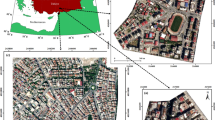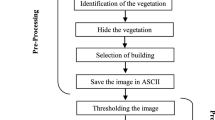Abstract
The paper focuses on automatic extraction of building stock information for quantifying physical exposure and its vulnerability from High and Very High Resolution (VHR) optical satellite imagery. We use two case studies. In Sana’a (Yemen), we use automatic techniques to extract the building stock as well as building height that is used to characterize its vulnerability. In Port-au-Prince (Haiti)—the area affected by the 2010 earthquake—we map the building stock based on a pre-disaster imagery, and we show the added value of area-based information when added to point-based damage assessment from visual change interpretation of post-disaster aerial images. This paper shows that VHR imagery can be used to locate and quantify the building stock and its height. This paper also shows that damages measured from changes detected from pre- and post-disaster imagery can in principle map and provide vulnerability information related to the structural fragility of the building stock.









Similar content being viewed by others
References
Blaschke T (2010) Object based image analysis for remote sensing. ISPRS J Photogramm Remote Sens 65(1):2–16. doi:10.1016/j.isprsjprs.2009.06.004
Brunner D, Soille P (2007) Iterative area filtering of multichannel images. Image Vis Comput 25(8):1352–1364
Brunner D, Soille P (2009) Towards building shadow extraction in VHR SAR images using mathematical morphology. In: Wilkinson M, Roerdink J (eds) Abstract book of the 9th international symposium on math. morph (ISMM’2009), pp 17–20, The Netherlands. University of Groningen. Available from http://www.cs.rug.nl/~ISMM09/ISMMabstractbook.pdf
Corban C, Saito K, Dell’Oro L, Bjorgo E, Gill S, Piard B, Huyck C, Kemper T, Lemoine G, Spence R, Shankar R, Senegas O, Ghesquiere F, Lallemant D, Evans G, Gartley R, Toro J, Ghosh S, Svekla W, Adamas B, Euguchi R (2011a) A comprehensive analysis of building damage in the 12 January 2010 Mw7 Haiti Earthquake using high-resolution satellite and aerial imagery. Photogramm Eng Remote Sens 77:997–1009
Corban C, Lemoine G, Al Khudhairy D, Kemper T, Van Leeuwen H, Pesaresi M, Gill S, Lallement D, Saito K, Eguchi R, Bjorgo E, Dell`Oro L, Van Damme O, Pisano F, Senegas O (2011b). Standard operating procedure—collaborative spatial assessment CoSA—Release 1.0. EUR 24671 EN. Publications Office of the European Union, Luxembourg (Luxembourg), JRC62313
Corban C, Carrion D, Lemoine G, Broglia M (2011c) Comparison of damage assessment maps derived from very high spatial resolution satellite and aerial imagery produced for the Haiti 2010 earthquake. Earthq Spectra 27:S199–S218
Crowley H, Bommer J (2006) Modelling seismic hazard in earthquake loss models with spatially distributed exposure. Bull Earthq Eng 4:249–273
Deichmann U, Ehrlich D, Small C, Zeug G (2011) Using high resolution satellite data for the identification of urban natural disaster risk. World Bank European Union Joint Report, p 81. Published by World Bank, Washington, 2011. Available from <http://www.gfdrr.org/gfdrr/node/813>
Ehrlich D, Tenerelli P (2012) Optical satellite imagery for quantifying spatio-temporal dimension of physical exposure in disaster risk assessments. Nat Hazards (in press)
Ehrlich D, Zeug G, Gallego J, Gerhardinger A, Caravaggi I, Pesares M (2010) Quantifying the building stock from optical high resolution satellite imagery for assessing disaster risk. Geocarto Int 25(4):281–293
Gamba P, Dell’Acqua F, Lisini G (2009) BREC: the built-up area RECognition tool. Joint Urban Remote Sensing Event, 22–24 May 2009, Shanghai
GECD (2012) Global earthquake consequences database within the global earthquake model initiative. http://www.globalquakemodel.org/risk-global-components/consequence-database. Accessed 12 Nov 2012
GEM (Global Earthquake Model) (2012) Global earthquake model initiative. http://www.globalquakemodel.org/. Last accessed on 13 Jan 2012
Gianinetto M (2008) Updating large scale topographic databases in Italian Urban areas with submeter QuickBird Images. Int J Navig Obs. http://www.hindawi.com/journals/ijno/2008/725429/. Last accessed on 13 Jan 2012
Government of Haiti (2010) Haiti earthquake PDNA: assessment of damage, losses, general and sectoral needs. Annex to the Action Plan for National Recovery and Development of Haiti. http://gfdrr.org/docs/PDNA_Haiti-2010_Working_Document_EN.pdf. Last accessed 12 March 2012
Gueguen L, Soille P, Pesaresi M (2011) Change detection based on information measure. IEEE Trans Geosci Remote Sens 49:4503–4515
Hancilar U, Tuzun C, Yenidogan C, Erdik M (2010) ELER software—a new tool for urban earthquake loss assessment. Nat Hazards Earth Syst Sci 10:2677–2696
ISDR (International Strategy for Diaster Risk Reduction) (2005). Hyogo Framework for Action 2015–2015, p 23. http://www.unisdr.org/2005/wcdr/intergover/official-doc/L-docs/Hyogo-framework-for-action-english.pdf. Last accessed on 20 September 2012
ISDR (International Strategy for Disaster Reduction) (2009) United nations international strategy for disaster risk reduction. Terminology on Disaster Risk Reduction. http://www.unisdr.org/we/inform/terminology. Last accessed on 13 Mar 2012
Kemper T, Lemoine G, Corbane C, Gill S, Eguchi R, Bjorgo E, Dell`Oro L (2010) Building damage assessment report—haiti earthquake 12 January 2010 Joint Damage Assessment. European Commission, JRC59706
Lee D, Shan J, Bethel J (2003) Class-guided building extraction from IKONOS. Photogramm Eng Remote Sens 69(2):143–150
Miura H, Midorikawa S, Fujimoto K (2004) Automated building detection from high-resolution satellite image for updating GIS building inventory data. In: 13th world conference on earthquake engineering Vancouver, BC, Canada, 1–6 August 2004
Miura H, Midorikawa S, Eeri M (2006) Updating GIS building inventory data using high-resolution satellite images for Earthquake damage assessment: application to Metro-Manila, Philippines. Earthq Spectra 22:151–168
Miyamoto HK, Gilani ASJ, Wong K (2011) Massive damage assessment program and repair and reconstruction strategy in the aftermath of the 2010 Haiti earthquake. Earthq Spectra 27:S219–S237
Nagao M, Matsuyama T, Ikeda Y (1979) Region extraction and shape analysis in aerial photographs. Comput Graph Image Process 10:195–223. doi:10.1016/0146-664X(79)90001-7
Ouzounis G, Soille P (2011) Pattern spectra from partition pyramids and hierarchies. Lect Notes Comput Sci 6671:108–119. doi:10.1007/978-3-642-21569-8_10
Ouzounis G, Soille P (2012) The alpha-tree algorithm. Technical report, Joint Research Centre, European Commission. doi:10.2788/48773
Ouzounis G, Soille P, Pesaresi M (2011) Rubble detection from VHR aerial imagery data using differential morphological profiles. In: Proceedings of 34th international symposium on remote sensing of the environment, Sydney, Apr, International Center for Remote Sensing of Environment (ICRSE) available on http://www.isprs.org/proceedings/2011/ISRSE-34/211104015Final00015.pdf. Last view 13 March 2012
Ouzounis G, Syrris V, Gueguen L, Soille P (2012) The switchboard platform for interactive image information mining. In Proceedings of 8th conference on image information mining, ESA-EUSC-JRC, Joint Research Centre of the European Commission, 2012. doi:10.2788/49465
Ozdemir B, Askoy S, Eckert S, Pesaresi M, Ehrlich D (2009) Performance measures for object detection evaluation. Pattern Recogn Lett 31:1128–1137
Poli D, Caravaggi I (2012) 3D modelling of large urban areas with stereo VHR satellite imagery for risk and damage assessment—lessons learned. Nat Hazards (this issue)
Poli D, Soille P (2012) Digital surface models extraction from ISPRS bench-mark stereo data and refinement through constrained connectivity partitioning. Photogramm Fernerkundung-Geoinf:317–329. doi:10.1127/1432-8364/2012/0120
Shao Y, Taff GN, Walsha SJ (2011) Shadow detection and building height estimation using IKONOS data. Int J Remote Sens 32(22):6929–6944
Soille P (2003) Morphological image analysis: principles and applications, 2nd edn. Springer, Berlin
Soille P (2005) Beyond self-duality in morphological image analysis. Image Vis Comput 23(2):249–257. doi:10.1016/j.imavis.2004.06.002
Soille P (2007) On genuine connectivity relations based on logical predicates. In: Proceedings of 14th international conference on image analysis and processing, Modena, Italy, pp 487–492. IEEE Computer Society Press, September 2007. doi:10.1109/ICIAP.2007.4362825
Soille P (2008) Constrained connectivity for hierarchical image partitioning and simplification. IEEE Trans Pattern Anal Mach Intell 30(7):1132–1145. doi:10.1109/TPAMI.2007.70817
Soille P (2009) Recent developments in morphological image processing for remote sensing. In: Bruzzone L, Benediktsson J, Serpico S (eds) Image and signal processing for remote sensing, volume SPIE-7477. SPIE, 2009. doi:10.1117/12.836024 [Invited paper]
Soille P (2010) Constrained connectivity for the processing of very high resolution satellite images. Int J Remote Sens 31(22):5879–5893. Erratum in the equation of page 5886: erosion (resp. dilation) must be replaced by gradient by erosion (resp. dilation). doi:10.1080/01431161.2010.512622
Soille P (2011) Preventing chaining through transitions while favouring it within homogeneous regions. Lect Notes Comput Sci 6671:96–107. doi:10.1007/978-3-642-21569-89
Stassopoulou A, Caelli Y (2000) Building detection using Bayesian networks. Int J Pattern Recognit Artif Intell 14(6):715–733
Taubenbock H, Esch T, Felbier A, Wiesner M, Roth A, Dech S (2012) Monitoring urbanization in mega cities from space. Remote Sens Environ 117:162–176. doi:10.1016/j.rse.2011.09.015
Taubenboeck H, Roth A, Dech S, Mehl H (2009) Assessing building vulnerability using synergistically remote sensing and civil engineering. In: Krek A, Rumor M, Zlatanova S, Fendel M (eds) Urban and regional data management. Taylor and Francis Group, London, pp 287–300
Zeug G, Eckert S (2010) Population growth and its expression in spatial built-up patterns: the Sana’a, Yemen case study. Remote Sens 2:1014–1034
Zucker S (1976) Region growing: childhood and adolescence. Comput Graph Image Process 5:382–399
Author information
Authors and Affiliations
Corresponding author
Rights and permissions
About this article
Cite this article
Ehrlich, D., Kemper, T., Blaes, X. et al. Extracting building stock information from optical satellite imagery for mapping earthquake exposure and its vulnerability. Nat Hazards 68, 79–95 (2013). https://doi.org/10.1007/s11069-012-0482-0
Received:
Accepted:
Published:
Issue Date:
DOI: https://doi.org/10.1007/s11069-012-0482-0




